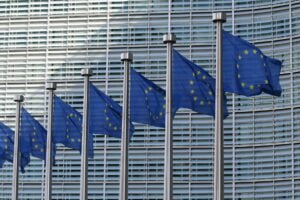This content was created by the Data Sharing Coalition, one of the founding partners of the CoE-DSC.
Data sharing is an important pillar of the data economy. Many data sharing initiatives, such as the Data Sharing Coalition (DSC), are working on various aspects (e.g., infrastructure, use cases) to realise its societal and economic potential. Clarity on the position of the DSC relative to comparable European generic data sharing initiatives allows the DSC to better contribute to realisation of the data economy. Therefore, the DSC analysed its relationship with other initiatives to determine similarities, unique aspects, and next steps to optimise its efforts.
All data sharing initiatives strive to unlock value of data sharing, but each has a unique signature
There are various existing data sharing initiatives that aim to realise the potential value of data sharing including:
- Generic data sharing initiatives, such as the Data Sharing Coalition, AMdEX, GAIA-X, GoFAIR Foundation, iSHARE and the NL AIC that provide overarching principles, standards, or functionalities for the data economy.
- Data space specific data sharing initiatives, such as MedMij, HDN, EDSN and Datenraum Mobilität, focus on data sharing within a single data space.
This analysis is performed by the DSC to understand the relationships between existing generic data sharing initiatives (mentioned above) with which it interacts closely. The considered initiatives have an aligned vision to unlock the value of data by sharing and re-using data on large scale while ensuring data sovereignty (i.e. the capability of an individual or an organisation to have control over their personal and business data). To understand each initiatives’ unique focus, a model based on the OPEN DEI Design Principles for Data Spaces has been set up for comparison. This model represents three layers required for an interoperable and scalable infrastructure for data sharing:
- The data spaces that allow users to exchange data based on harmonised agreements
- The soft infrastructure that defines the generic (technology neutral) agreements required to facilitate interoperable data sharing in spaces
- The hard infrastructure and associated software to create interoperability, connectivity, and portability between storage providers.
Figure 1 shows the comparison between the considered initiatives and indicates the unique signature of each initiative. For example, the DSC aims to enable data sharing between data spaces (existing data sharing initiatives) by considering the complete set of required generic soft infrastructure building blocks. Compared to this, GAIA-X develops the foundations for a federated, open data and cloud infrastructure based on European values whereas iSHARE has a generic operational scheme for identification, authentication, and authorisations which can be applied in all types of data spaces.

The efforts of the DSC in the data economy is complementary to those of other considered generic data sharing. To strengthen the public awareness for everyone, communication of the initiatives should be aligned. Furthermore, collaboration tailored to the unique signatures of the considered initiatives allows them to ensure an efficient approach to maximally contribute to the realisation of the data economy, this in turn strengthens each initiative.
The DSC will collaborate with other data sharing initiatives around use cases and leveraging existing expertise
To realise mutually beneficial results, the DSC and other considered initiatives with an aligned vision should collaborate on use cases where relevant to optimise the impact of use cases. Collaboration on use cases allows each initiative to effectively contribute using their unique expertise and learn from the practical implementation of the use cases. The table below details the next steps in the collaboration between the DSC and the considered initiatives.
| Initiative | Planned collaboration efforts of DSC with other data sharing initiatives |
| AmdEX | Continue and seek collaboration in (new) data sharing use cases where the layer between hard and soft infrastructure is relevant· Ensure scalability by jointly investigating data sharing archetypes (e.g. transactional, streaming & auctions, etc.) Explore enabling the future DSC Trust Framework agreements as machine readable digital contractsEnsure the legal agreements of the DSC Trust Framework are usable by AMdEX technology through alignment |
| GAIA-X | Explore how the DSC Data Sharing Canvas and the GAIA-X architectures relateSeek collaboration with the GAIA- X Hub NL in data sharing use cases where the hard infrastructure is relevantEnsure convergence and interoperability of data spaces on European level, for example through the Ministry of Economic Affairs and Climate IPCEI callExplore additional collaboration, such as for awareness creation |
| GoFAIR Foundation | Explore alignment between the existing FAIR data principles and the future DSC Trust FrameworkContinue collaboratively supporting use cases to add value by combining GFF and DSC’s complementary servicesMake use of the GFF international network when considering international growth. Build upon existing collaboration, for example expanding on the joint proposal for the Nationaal Groeifonds |
| International Data Spaces Association | Explore the use of IDSA’s reference architecture as one of the building blocks for the DSC Trust FrameworkOptimise value created for data sharing use case through collaboration when the technical implementation of the use case is relevantExplore the possibility of IDSA making use of the DSC set-up for other national data sharing programsEnsure convergence and interoperability of data spaces on European level through collaboration |
| iSHARE | Explore the use of iSHARE as one of the building blocks for the DSC Trust Framework during its developmentContinue collaboratively supporting use cases to optimise value created for data sharing use cases through collaboration when the IAA building block is relevant to gain practical insights on the use of iSHARE as a building block in the DSC Trust FrameworkContinue close cooperation with iSHARE in the DSC Harmonisation group |
| NL AIC Data Sharing working group | Explore synergies and alignment between the DSC Data Sharing Canvas and the NL AIC guidelines and standardsExplore how (future) results from NL AIC can be used as building blocks for DSC, e.g. software componentsOptimise value created for data sharing for AI application use case through collaboration to gain practical insightsContinue cooperation between the DSC and NL AIC Data Sharing Working Group on knowledge sharing |
For a detailed analysis of each of the initiatives, as well as details on the presented model, see the paper.
For more information regarding the Data Sharing Coalition and this analysis, contact us at: info@coe-dsc.nl




